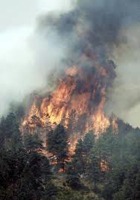Reflecting on Colorado’s Wildfires
 Wildfires have burned in Colorado early and often this year, with unprecedented losses of personal property and forest acreage. Increasing numbers of people–now 1 out of 5 in Colorado- -live in so-called “red zones,” areas at high risk of fires. Climate change has also been a factor, bringing warmer and dryer weather. Throughout the centuries, naturally occurring fires kept forest acreage healthy, but in the last century fires have been largely suppressed, contributing to more growth of underbrush. This growth, allowed to accumulate, gives pine beetles more to chew on, creates more fuel for fires, and makes new fires harder to control.
Wildfires have burned in Colorado early and often this year, with unprecedented losses of personal property and forest acreage. Increasing numbers of people–now 1 out of 5 in Colorado- -live in so-called “red zones,” areas at high risk of fires. Climate change has also been a factor, bringing warmer and dryer weather. Throughout the centuries, naturally occurring fires kept forest acreage healthy, but in the last century fires have been largely suppressed, contributing to more growth of underbrush. This growth, allowed to accumulate, gives pine beetles more to chew on, creates more fuel for fires, and makes new fires harder to control.
It is more and more costly, now nearly half its budget, for the Forest Service to provide high country residents protection for their property and their lives. In today’s Denver Post, a writer made the point that currently, rather than those who live in red zones helping to pay for their own higher risk of property loss, the cost of fighting wildfires is shared by all taxpayers. That shared cost makes it more appealing to live in those areas. People should be able to live anywhere they want, but given the high cost of fighting fires, shouldn’t people who choose to live in high risk areas pay some of the cost? If an extra cost to homeowners discourages people from living in red zones, that would be beneficial, ultimately reducing the number of homes needing protection. Homeowners in red zones could be assessed a additional fee for wildfire protection as part of their property tax, for example.
Another concern I have is about the hundreds of thousands of gallons of fire retardant dumped on these fires. Last year, the U.S. Forest Service released a 370-page report on the effects of these chemicals. Retardants kill fish, contaminate aquifers and fertilize noxious weeds. According to an analysis of the report in High Country News, “Chemical fire retardants do slow a fire’s progress and help firefighters construct fire lines. But they don’t keep wind-driven embers from igniting cedar-shake roofs where communities border wilderness, which is arguably the best reason to extinguish fires. Jack Cohen, a Forest Service scientist in Missoula, Mont., has found that homes can survive even high-intensity crown fires if they’re constructed of the right materials and surrounded by a 200-foot buffer zone. Fire suppression has little to do with it.” Critics say that studies more accurately accessing the effectiveness of retardants are needed.
I will be interested to see the unfolding discussion on these and other wildfire-related issues. As the climate continues to warm, wildfires such as we have seen in the past month are not likely to be that unusual.



